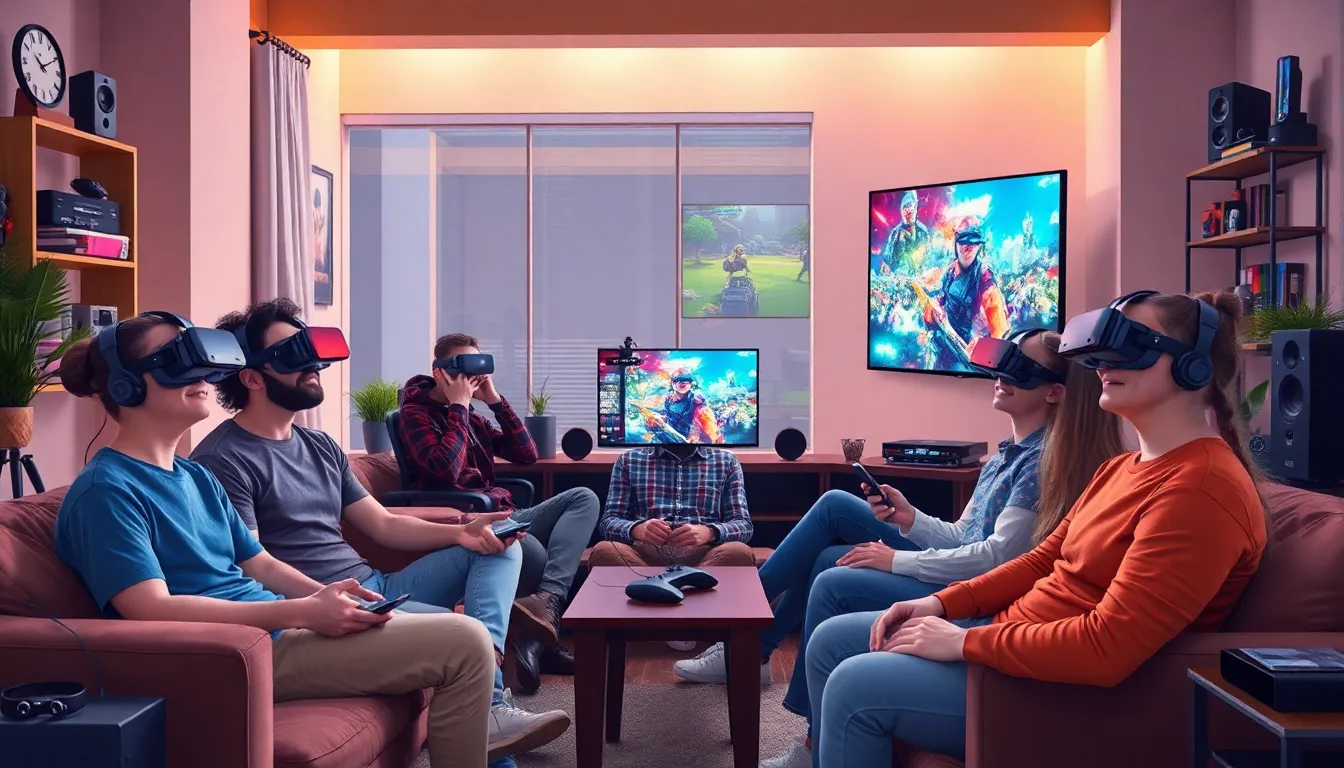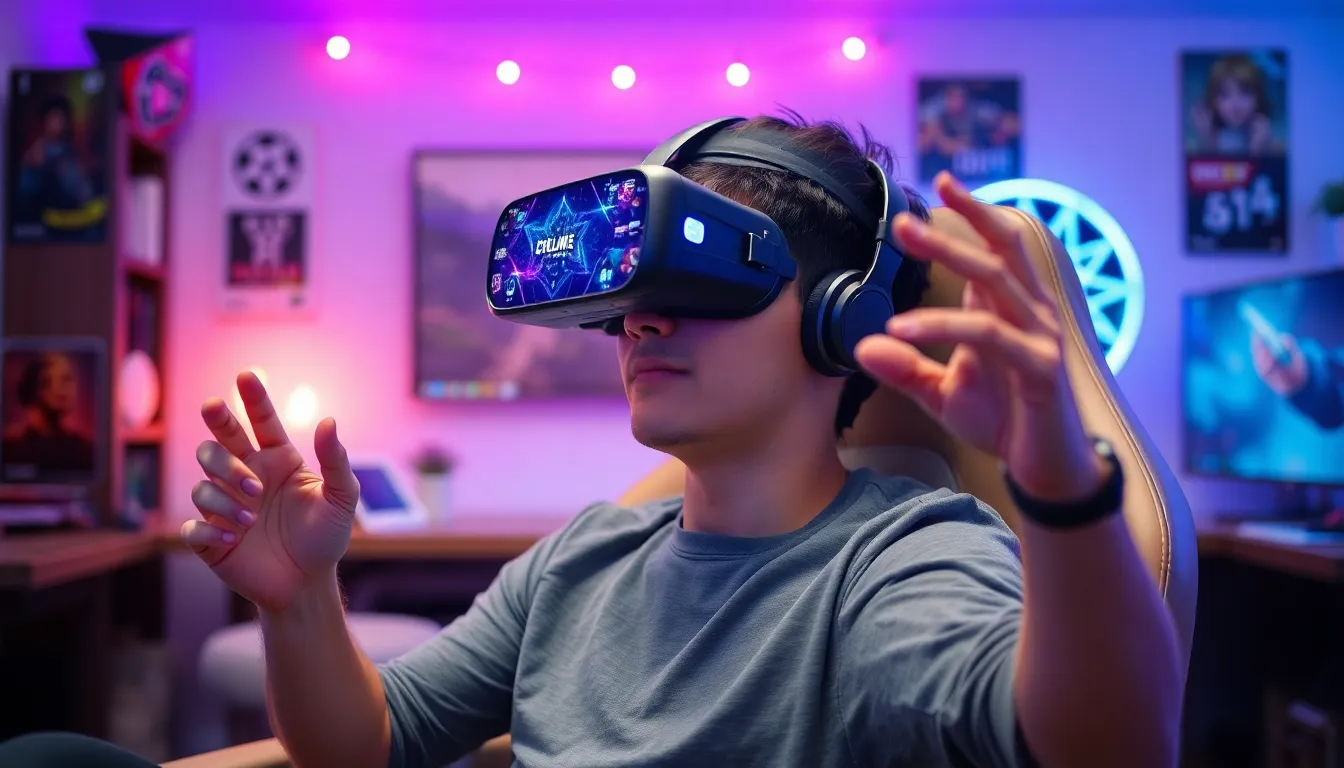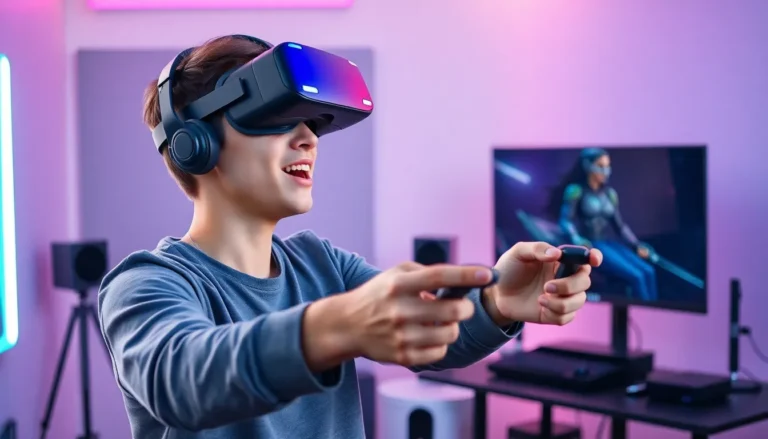Imagine slipping on a VR headset and diving headfirst into a world where your living room transforms into a vast battlefield or a serene fantasy realm. Welcome to the exciting universe of VR cloud gaming, where the power of the cloud meets the thrill of virtual reality. Gone are the days of needing expensive consoles or high-end PCs; now, all you need is a solid internet connection and a sprinkle of imagination.
Table of Contents
ToggleWhat Is VR Cloud Gaming?
VR cloud gaming combines virtual reality with cloud computing, enabling immersive gaming experiences without the need for local hardware. Users access games via the internet, streaming high-quality graphics directly to their VR headsets. This method eliminates the requirement for expensive gaming systems or top-tier PCs, making cutting-edge games more accessible.
Cloud servers process game data and render visuals, sending them to the headset in real time. Players enjoy high-resolution graphics and responsive controls, similar to playing on a powerful console. Many popular games are optimized for this platform, offering various genres that cater to diverse tastes.
Latency remains a key concern in VR cloud gaming. With fast internet speeds around 25 Mbps or higher, players can experience minimal lag. Successful providers ensure their infrastructure meets these requirements, enhancing user satisfaction.
The ecosystem includes major players like NVIDIA GeForce NOW and PlayStation Now, each offering distinct advantages. Subscriptions typically grant access to extensive libraries of VR titles, allowing users to explore vast virtual worlds. This model fosters an inclusive gaming community.
Technological advancements continuously enhance the VR cloud gaming landscape. Improved compression algorithms and faster broadband speeds play significant roles in delivering a seamless experience. As the industry progresses, VR cloud gaming evolves into an increasingly reliable platform for enthusiasts.
Benefits of VR Cloud Gaming

VR cloud gaming offers significant advantages, making it an appealing choice for many players. This immersive experience enhances gameplay, accessibility, and overall enjoyment.
Accessibility and Convenience
Accessibility plays a crucial role in VR cloud gaming. Users require only a VR headset and a stable internet connection to dive into virtual worlds. No need for expensive hardware or gaming consoles. This simplicity attracts a diverse range of players, including those who previously lacked opportunities for high-quality gaming experiences. Convenience matters, too, as players can access a variety of titles from home without the hassle of physical copies. Instant access to streaming libraries means that exploring new games becomes seamless and effortless.
Cost-Effectiveness
Cost-effectiveness serves as another key benefit of VR cloud gaming. Players save money by avoiding hefty upfront investments in gaming consoles or high-performance PCs. Subscription models offered by platforms like NVIDIA GeForce NOW and PlayStation Now provide access to extensive libraries for a reasonable monthly fee. Numerous titles can be explored without purchasing each one individually. This approach allows gamers to experience different genres without financial risk. Overall, VR cloud gaming democratizes high-quality gaming experiences, making them more affordable for everyone.
Key Technologies Behind VR Cloud Gaming
Technological innovations drive VR cloud gaming, creating an immersive experience for users. Two primary components form the foundation of this advanced gaming platform.
Cloud Infrastructure
Cloud infrastructure comprises powerful servers capable of processing vast amounts of data. These servers host games and stream high-quality graphics directly to VR headsets. Notably, robust data centers are strategically located to minimize latency, enhancing user experience. Providers like Google and Microsoft leverage advanced cloud solutions to support real-time processing of graphics. Furthermore, these infrastructures utilize scalable resources, allowing flexibility as demand increases during peak gaming hours. Optimized data transfers significantly reduce lag, ensuring a seamless gaming session for users.
VR Hardware Compatibility
VR hardware compatibility plays a crucial role in the effectiveness of VR cloud gaming. Various headset models support different platforms, enabling a broader audience to engage with cloud gaming. Popular headsets like Oculus Quest 2 and HTC Vive offer excellent support for most cloud gaming services. Each device’s specifications, including resolution and refresh rates, directly impact the immersive experience. Additionally, consistent updates from hardware manufacturers ensure compatibility with new cloud technologies. Integrating advanced sensors and controllers further enhances user interaction, making gameplay more intuitive and engaging.
Popular VR Cloud Gaming Platforms
Numerous platforms deliver VR cloud gaming experiences that captivate players. NVIDIA GeForce NOW stands out with its expansive library, featuring both AAA titles and indie games. Subscribers access high-quality graphics rendered in real-time, minimizing loading times and latency.
PlayStation Now offers a wealth of VR titles alongside traditional games. This platform caters to users with its user-friendly interface, making it easy to explore various genres. Subscribers enjoy regular updates, ensuring a fresh gaming experience.
Oculus Cloud Gaming provides seamless integration for Oculus Quest 2 users. The platform leverages Oculus Link for enhanced graphics performance, allowing players to connect to a powerful gaming PC. High-speed internet access remains essential for the best experience.
Vortex Cloud Gaming emphasizes accessibility, supporting multiple devices. Users appreciate the ability to play on smartphones, tablets, and PCs without elaborate setups. This flexibility opens up gaming to a wider audience.
Shadow Cloud Gaming distinguishes itself through its customizable virtual machines. Players can configure their settings to optimize performance based on their preferences. Diverse specifications enable a tailored experience for each gamer.
Google Stadia enters the arena with a distinctive focus on streaming. Its low-latency technology ensures smooth gameplay, even in demanding titles. Integration with Chromecast Ultra enhances the experience for users with VR headsets.
Lastly, Amazon Luna builds excitement by offering a subscription model. This platform features a rotating library of games, encouraging players to try new titles. Continuous improvement of backend infrastructure ensures higher performance and reliability for gamers.
Challenges of VR Cloud Gaming
VR cloud gaming presents several challenges that affect user experience and accessibility. Two primary concerns include latency issues and bandwidth requirements.
Latency Issues
Latency significantly impacts gameplay fluidity, causing noticeable delays between actions and corresponding on-screen responses. Fast internet speeds of 25 Mbps or higher decrease lag, but many players still experience hiccups in responsiveness due to cloud server distances. Cloud processing introduces varying degrees of latency, which affects competitive gaming and immersion. While some platforms minimize these hurdles with proximity to data centers, others struggle with consistency in response times. Developers and providers continue to innovate methods to reduce latency, ensuring a smoother experience for users.
Bandwidth Requirements
High-quality VR cloud gaming requires robust bandwidth to deliver seamless gameplay and crisp graphics. A minimum of 25 Mbps is needed for optimal performance, but higher speeds are preferable for an uninterrupted experience. Inadequate bandwidth results in pixelated visuals and lag, which detracts from immersion and overall enjoyment. Users must ensure their internet connections meet these demands, often requiring upgrades to existing plans. As technology advances, the potential for improved compression techniques may help lower overall bandwidth needs without sacrificing quality.
VR cloud gaming is reshaping the landscape of interactive entertainment. By merging virtual reality with cloud technology, it offers gamers an unprecedented level of accessibility and convenience. With a simple VR headset and a reliable internet connection, players can dive into rich virtual worlds without the burden of costly hardware.
Despite challenges like latency and bandwidth demands, the benefits far outweigh the drawbacks. As technology continues to evolve, solutions to these issues will likely emerge, enhancing the overall gaming experience. With major platforms leading the charge, VR cloud gaming is set to become a staple in the gaming community, inviting more players to explore its immersive potential.





